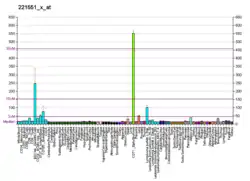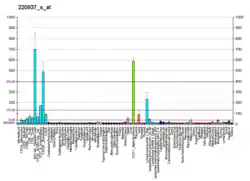ST6GALNAC4
ST6 (alpha-N-acetyl-neuraminyl-2,3-beta-galactosyl-1,3)-N-acetylgalactosaminide alpha-2,6-sialyltransferase 4, also known as sialyltransferase 3C (SIAT3-C) or sialyltransferase 7D (SIAT7-D) is a sialyltransferase enzyme that in humans is encoded by the ST6GALNAC4 gene.[5]
Function
ST6GALNAC4 is a type II membrane protein that catalyzes the transfer of sialic acid from CMP-sialic acid to galactose-containing substrates. The encoded protein prefers glycoproteins rather than glycolipids as substrates and shows restricted substrate specificity, utilizing only the trisaccharide sequence Neu5Ac-alpha-2,3-Gal-beta-1,3-GalNAc. In addition, it is involved in the synthesis of ganglioside GD1A from GM1B. The enzyme is normally found in the Golgi apparatus but can be proteolytically processed to a soluble form. This protein is a member of glycosyltransferase family 29. Transcript variants encoding different isoforms have been found for this gene.[5]
References
- GRCh38: Ensembl release 89: ENSG00000136840 - Ensembl, May 2017
- GRCm38: Ensembl release 89: ENSMUSG00000079442 - Ensembl, May 2017
- "Human PubMed Reference:". National Center for Biotechnology Information, U.S. National Library of Medicine.
- "Mouse PubMed Reference:". National Center for Biotechnology Information, U.S. National Library of Medicine.
- "Entrez Gene: ST6GALNAC4 ST6 (alpha-N-acetyl-neuraminyl-2,3-beta-galactosyl-1,3)-N-acetylgalactosaminide alpha-2,6-sialyltransferase 4".
Further reading
- Lanfranchi G, Muraro T, Caldara F, et al. (1996). "Identification of 4370 expressed sequence tags from a 3'-end-specific cDNA library of human skeletal muscle by DNA sequencing and filter hybridization". Genome Res. 6 (1): 35–42. doi:10.1101/gr.6.1.35. PMID 8681137.
- Lee YC, Kaufmann M, Kitazume-Kawaguchi S, et al. (1999). "Molecular cloning and functional expression of two members of mouse NeuAcalpha2,3Galbeta1,3GalNAc GalNAcalpha2,6-sialyltransferase family, ST6GalNAc III and IV". J. Biol. Chem. 274 (17): 11958–67. doi:10.1074/jbc.274.17.11958. PMID 10207017.
- Gilley J, Fried M (1999). "Extensive gene order differences within regions of conserved synteny between the Fugu and human genomes: implications for chromosomal evolution and the cloning of disease genes". Hum. Mol. Genet. 8 (7): 1313–20. doi:10.1093/hmg/8.7.1313. PMID 10369878.
- Harduin-Lepers A, Stokes DC, Steelant WF, et al. (2001). "Cloning, expression and gene organization of a human Neu5Ac alpha 2-3Gal beta 1-3GalNAc alpha 2,6-sialyltransferase: hST6GalNAcIV". Biochem. J. 352 Pt 1: 37–48. PMC 1221430. PMID 11062056.
- Moody AM, North SJ, Reinhold B, et al. (2003). "Sialic acid capping of CD8beta core 1-O-glycans controls thymocyte-major histocompatibility complex class I interaction". J. Biol. Chem. 278 (9): 7240–6. doi:10.1074/jbc.M210468200. PMID 12459555.
- Strausberg RL, Feingold EA, Grouse LH, et al. (2003). "Generation and initial analysis of more than 15,000 full-length human and mouse cDNA sequences". Proc. Natl. Acad. Sci. U.S.A. 99 (26): 16899–903. doi:10.1073/pnas.242603899. PMC 139241. PMID 12477932.
- Kim SW, Kang NY, Lee SH, et al. (2003). "Genomic structure and promoter analysis of human NeuAc alpha2,3Gal beta1,3GalNAc alpha2,6-sialyltransferase (hST6GalNAc IV) gene". Gene. 305 (1): 113–20. doi:10.1016/S0378-1119(02)01234-9. PMID 12594047.
- Ota T, Suzuki Y, Nishikawa T, et al. (2004). "Complete sequencing and characterization of 21,243 full-length human cDNAs". Nat. Genet. 36 (1): 40–5. doi:10.1038/ng1285. PMID 14702039.
- Gerhard DS, Wagner L, Feingold EA, et al. (2004). "The status, quality, and expansion of the NIH full-length cDNA project: the Mammalian Gene Collection (MGC)". Genome Res. 14 (10B): 2121–7. doi:10.1101/gr.2596504. PMC 528928. PMID 15489334.
- Kang NY, Park YD, Choi HJ, et al. (2005). "Regulatory elements involved in transcription of the human NeuAcalpha2,3Galbeta1,3GalNAcalpha2,6-sialyltransferase (hST6GalNAc IV) gene". Mol. Cells. 18 (2): 157–62. PMID 15528990.
- Olsen JV, Blagoev B, Gnad F, et al. (2006). "Global, in vivo, and site-specific phosphorylation dynamics in signaling networks". Cell. 127 (3): 635–48. doi:10.1016/j.cell.2006.09.026. PMID 17081983. S2CID 7827573.





